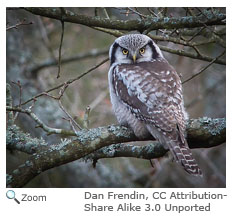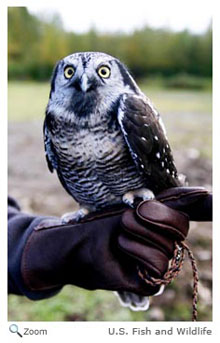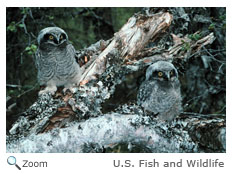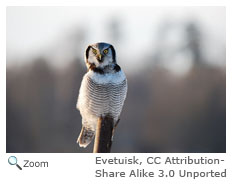Description
 Smaller than a crow, the Northern Hawk Owl is only about 16 inches tall. Its wings, head and back are dark brown with white spots, but its belly is white with thin brown horizontal stripes. The Northern Owl has no ear tufts and a very long tail. Smaller than a crow, the Northern Hawk Owl is only about 16 inches tall. Its wings, head and back are dark brown with white spots, but its belly is white with thin brown horizontal stripes. The Northern Owl has no ear tufts and a very long tail.
Range
The Northern Hawk Owl has a very northern range. It is found from northern Alaska through lower and middle Canada. It is also found along the northern edge of the United States.
Habitat
 The Northern Hawk Owl lives in northern coniferous forests. It prefers a habitat on the edge of a clearing such as a muskeg (bog), or mountain range. While perched in a tree, the Northern Hawk Owl can hunt in the cleared area. The Northern Hawk Owl lives in northern coniferous forests. It prefers a habitat on the edge of a clearing such as a muskeg (bog), or mountain range. While perched in a tree, the Northern Hawk Owl can hunt in the cleared area.
|
|
Diet
 Hunting during the day and night, the Northern Hawk Owl preys on small mammals like voles, lemmings, snowshoe hairs and squirrels. In the summer, the owl eats rodents. In the winter, the Northern Hawk Owl sometimes eats ptarmigan and grouse. Hunting during the day and night, the Northern Hawk Owl preys on small mammals like voles, lemmings, snowshoe hairs and squirrels. In the summer, the owl eats rodents. In the winter, the Northern Hawk Owl sometimes eats ptarmigan and grouse.
Life Cycle
 Breeding season for the Northern Hawk Owl is from March to June. In a tree cavity, abandoned nest or sometimes a cliff, the owl lays between 3 and 13 eggs. The female incubates her eggs for about a month. During this time, the male brings the female food and protects her nest from predators. Breeding season for the Northern Hawk Owl is from March to June. In a tree cavity, abandoned nest or sometimes a cliff, the owl lays between 3 and 13 eggs. The female incubates her eggs for about a month. During this time, the male brings the female food and protects her nest from predators.
Before they hatch, chicks will peep from inside their eggs. Once they hatch, young Northern Hawk Owls stay with their parents for about 4 weeks until they fledge and leave the nest.
Behavior
 The Northern Hawk owl flies during the day, which leads many people to think it behaves more like a hawk than an owl. The Northern Hawk owl flies during the day, which leads many people to think it behaves more like a hawk than an owl. |





